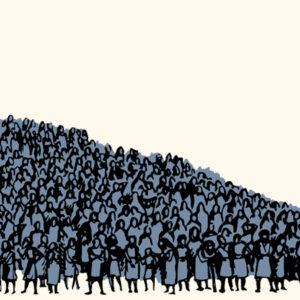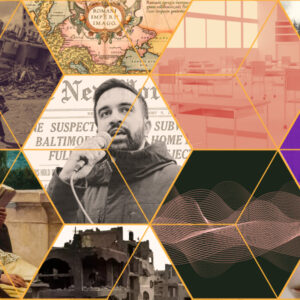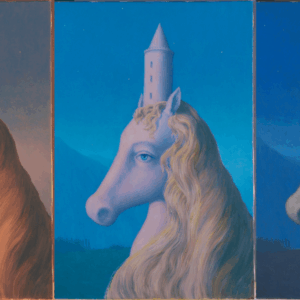
On the Moral and Metaphysical Significance of Aloneness
Sumana Roy Considers Solitary Ways of Being
At first I come to it like an outsider. I look at a solitary tree on a field or mountain top. I am struck by its beauty, but the moment soon dissolves into secondhand sadness. I want to feel sad for the tree because I imagine the tree to be sad, sad because it is alone. Not until I’m much older do I begin to see that trees photograph best when they are alone, and not in a group. I try to find a moral about aloneness in this. I fail.
I discover this about several other things: lightning, one flash tearing the sky like a rag being ripped apart; lone chimney smoke tickling the sky; the middle parting of hair; the head; perhaps even the heart, though I sometimes wish I had more than one heart, like the giraffe and the octopus, which have three, hoping that the distribution of pain among the hearts would reduce my sadness; one television in one room (imagine if there were more!).
From time to time, particularly when I am eating alone, I find myself thinking about the single grain of rice that Draupadi is supposed to have transformed into a meal—the aloneness of not just the eater but of the eaten.
*
I think about the difference between singular and singularity. In my head, walking on a street, one day I find the word on a wall. I stand transfixed by it: Alone. My eyes break it up: Al + one. I feel sad for the “one” in the word, that it was so lonely that it needed two more letters, that it needed to add “all,” its opposite, to feel less alone. It is a summer day and I am alone on the street in the mid-afternoon heat. Even my shadow has disappeared somewhere—on to the walls or inside the shops that line the street. Darkness has swallowed it, like it does every night. Is that why we feel more alone at night, without our shadow? What is left is me on the street—alone. I look like 1. “I” looks like “1,” as we all know.
For years I did not feel alone. For years I did not think of “I” as “1.” I cannot say, for I am no theorist, whether it was that awareness that brought on the sense of aloneness. Like I do not know whether it was a sense of acute aloneness that made 1 add exactly one more of itself to become 2 and then another of itself to become 3 and so on… how adding 1 and then 1 and then 1 and then 1 more and another 1 seems to be the way to reach the infinite, the cure for aloneness seems to be almost similar. 1 and aloneness on one side and infinity and lack of aloneness on the other—is that the journey one wants to make?
Having started as an outsider to aloneness at some point of time, without awareness, I, like 1, moved to the other side. I’m not only an insider, I’m also an integer of aloneness, as much as 1 is to all the numbers that have followed it. This journey from outsider to insider is a movement from the epic to the lyric, the panorama of community to the intimacy of aloneness, the jungle to the last leaf on a tree. I think of the ancients—their literature is a rejection of aloneness, their literary forms are communal forms. By community I do not mean a pack of numbers, but an invisible dust that connects one to the other, like the spine connects our legs to our head. Aloneness, as I experience it, and as I imagine moderns experience it, began the moment the impulse for the epic turned to the lyric.
*
One’s awareness of aloneness arrives late, even later than being in love. One is alone because one is not alone in this world. It seems like a paradox, that our sense of aloneness should be dependent on even the numerical presence of others, of others like us, of the same species. Adam, for instance, was supposed to have felt alone, so that God felt the need to create someone for him—the someone for him had to be someone like him. Perhaps that is why children need toys that resemble them.
I am thinking of Robinson Crusoe, all alone on his island. The first novel in the English language is about a man who is completely by himself on an island (please note that it’s I-land, and in the case of the novel also 1-land). The epistolary novels in the English language that follow it are also a manifestation of aloneness, the writing of letters and the need to be heard. Isolation. I-so-lation. And yet there are varying responses to isolation: the lone goldfish in a bowl generates feelings that are different from a single finger on a hand. In the case of the first, the lone goldfish, we feel the need for sanga, for company—think of the Buddha’s ‘sangh’—to be a default mode: it demands addition. In the case of the second, what terrifies us is the subtraction, the aloneness resulting from something that has been taken away. Both are factors of aloneness.
*
I look at the uneven ends of my hair, grown unchecked, without trimming, over more than a year of the pandemic. In March 2020, when Geeta, my friend, a hairdresser, gave me a haircut, she had restored a kind of equality among neighboring groups of hair. Now that was gone. As I touched them to the soft of my fingers, I wondered whether those who’d grown longer felt more alone than those who were catching up. I also thought about whether it was my conditioning in an adage about competitiveness like “It gets loneliest at the top” that made me feel sad for the longest strands of hair; the other had to do with why the comparative and superlative for “lonely” was “lonelier” and “loneliest” while that for “alone” was “more alone” and “most alone.” Was it impossible for the alone to allow anything, even a suffix, to attach to itself?
The sense of aloneness isn’t a constant—it changes, like daylight.
What exactly was aloneness, and was it exclusive to human experience? Was it universal? Were there people who did not feel alone, and was not feeling alone “normal”? These thoughts came to me as I watched a 3-minute video on YouTube. It was about two towns in America—the first with a population of 1 person, the second with a population of 2 people. The older woman in the one-woman town said that she did not want to leave the town—she was there out of choice. The other, a couple, said she was happy to allow her husband to be the Mayor of the two-citizen town. I wondered whether the lone woman’s aloneness was different from the couple’s, and whether the couple could experience a similar aloneness together.
*
The sense of aloneness isn’t a constant—it changes, like daylight. It might also be related to the light in a day. For there is something about the character of light that exacerbates or lessens the sense of aloneness. Night allows these feelings a lavish home, outside the scrutiny and judgment of the day. I feel most alone during the night. Everything that belongs to the night—sleep and dreams—are utterly private; they cannot be shared.
Daylight produces the shadow, a companion, but it also reiterates a kind of kinship between everything outside us and the crevices and gashes of our mind. We are related to each other by our mortality—so it is the inevitability of death that makes us relatives to the living, to plant and animal life, and also to the elements, all of which go through the same cycle. Night is a fog—it takes away that comfort of relationality. We are left alone, all alone. All alone—what a sad oxymoronic phrase that is, borrowing the absence of “all” just to feel less alone. Alone, alone, all, all alone, Alone on a wide wide sea! The repetition of nearly every word in the lines—alone alone all all alone alone wide wide—because saying them once wouldn’t be enough, such is the depth of aloneness, is not the only thing here.
These words in Coleridge’s poem are said on the sea—in a space where the alienation from land, from our visible relatives there, amplify the sense of aloneness. Night, a thing associated with time, becomes spatial, like the sea and the sky and the desert.
I am too absent-spirited to count;
The loneliness includes me unawares.
And lonely as it is, that loneliness
Will be more lonely ere it will be less—
A blanker whiteness of benighted snow
With no expression, nothing to express.
They cannot scare me with their empty spaces
Between stars—on stars where no human race is.
I have it in me so much nearer home
To scare myself with my own desert places.
Notice how many times Robert Frost uses the word “lonely” and “loneliness” and “more lonely” and how that sense transfers to the spatial—”a blanker whiteness,” “empty spaces,” “my own desert places.” Aloneness is a continent emptied out—by light, by snow, by water, even by the imagination. “Between stars—on stars where no human race is.” Distance—long-distance, inter-galactic distance—becomes the unit of aloneness.
Frost’s poem carries a Hindi song to me. It is in the voice of one of my favorite singers, Kishore Kumar:
Badi sooni sooni hai zindagi yeh zindagi
“Life is very empty.” I translate the opening line in this matter-of-fact paraphrase deliberately. For that is what it is—a song that is about aloneness, about its emptiness, which, like all music, tries to measure space through time, in this case, in a two-minute, 40 second song. It’s from the Hindi film Mili—Mili is the name of the young woman in the film, but it also means “found,” as in someone or something being found. In the context of this song about aloneness, I am tempted to read it as a search for a person being found as a cure for aloneness.
Badi sooni sooni hai, zindagi ye zindagi
Main khud se hun yahaan ajnabi ajnabi
Like in the Coleridge and Frost poems, aloneness is stressed through repetition—”sooni sooni,” empty-empty; “zindagi yeh zindagi,” life this life; “ajnabi ajnabi,” stranger stranger. Such is the aloneness of my life that I’ve become a stranger to myself—and hence the echoing words, for the need of more than one person inside us. Or, such is the aloneness in my life that to populate it with one more person besides myself, I have had to turn to myself, to make myself a stranger, so that it seems like I am cohabiting this life with someone else. (We will see the actor Amitabh Bachchan, for whom Kishore Kumar is singing this song, pick up the same metaphor of two people inside one, in “Main aur meri tanhai aksar yeh baatein kartey hain, tum hoti toh kaisa hota …,” a compulsive characteristic of aloneness that extends the idea of Whitman’s “I contain multitudes,” or “1 contain multitudes,” in another film later.)
Kabhi ek pal bhi kahin yeh udasi
Dil mera bhuley
Tabhi muskurakar dabe paanw akar
Dukh mujhe chhun le
Sometimes just for a moment,
my heart is able to forget this sadness.
Right then, sadness comes on tiptoe
and touches me
Notice how two words for sadness are used: udasi and dukh. Like the two selves who live like strangers to ward off this sense of aloneness, sadness too comes in various forms, in various names—the same word would amplify the sense of aloneness, and so dukh, udasi, gam. What is most haunting here is the personification of sadness—of Dukh coming on tiptoe… Such is the state of aloneness, that Dukh is imagined as a person who is coming to give company to this person in acute emptiness. Sooni sooni… Note the movements of the mouth to say “sooni sooni”—soo, out; ni, in. Like you and me. The world and the self. Outside and inside. The need for someone outside myself to populate my world.
Na kar mujh se gam mere dillagi ye dillagi
The plea to sadness—to gam—to not tease him anymore.
Kabhi main na soya, kahin mujh se khoya
Sukh mera aise
Pata naam likh kar kahin yunhi rakhkar
Bhule koi jaise
Ajab dukh bhari hai ye bebasi bebasi
I haven’t slept, I’ve lost much—happiness… There’s an important thing to notice here. Kabhi, when—time; kahin, where—space. For a moment, just for a moment, there is this groping to imagine aloneness as a function of time, but it is momentary. For what follows next is a reiteration of space, and not just place alone. Pata naam likh kar—the name and the address, of whom? Of aloneness. There it is, aloneness with a location, occupying space. And it becomes a person again—what is invoked, over and over again, is forgetfulness. The person suffering from aloneness forgets, and aloneness, when transformed into a person, forgets as well; hence the bebasi, the hopelessness.
*
When I think of the moments when I am not aware of my aloneness, I notice certain similarities between them. I can list two such moments at random. The first is of watching my little nephew and niece play, run, learn to talk, where every moment seems to me to be a moment of experiencing ananda, joy. The second is of me listening to a favorite song; even if it is a song about sadness, I am able to participate in its—for want of a more appropriate word—sweetness. Both are moments of participation, even though I might be alone in a physical sense, as when, for example, I am observing my nephew and niece from a distance or on a video call. The same is true of my experience of the song.
In both moments, I have become something more than myself. I have expanded. I have become more than 1. It is a moment of proxy: I experience the joy of the children as if I were them, I experience the song as if they were my emotions. This moment of vicarious living is an escape from aloneness.
*
I think of the letters “I” and “U.” Notice how “U” is two “I”s joined together, touching each other’s toes under a table in a restaurant. I scrutinize “I” and “U” like a detective searching for clues—does “I” look more alone than “U”? Take two words where the “I” and “u” can be substituted for the other: “collision” and “collusion.” Note the violence that “I” causes in “collision” and the coming together that “u” generates in “collusion.” Two Is connected by a bridge. Where is the aloneness then? Isn’t it in the “I”?
Think of 1, in the languages you know. Its shape—in Bangla, Devanagiri, Arabic, and so on. They are all thin and tall, whether with a head on top, or crouching in fierce aloneness. In one of the Chinese scripts, it is so exhausted by aloneness that it lies horizontal. When I think of life, I think of it as addition—of the next, the n plus one: a day, an hour, a year, a wish, a desire, hope, anything that makes us wait for the next moment, the next. Aloneness is a function of that inbuilt sense of numbers inside us as well. It’s waiting to become more than one.
And yet this is aloneness: even though we refer to ourselves as 1—oneself—one feels like zero even though one is one.
Sumana Roy
Sumana Roy is the author of How I Became a Tree, just out from Yale University Press, Missing: A Novel, Out of Syllabus: Poems, and My Mother’s Lover and Other Stories.












